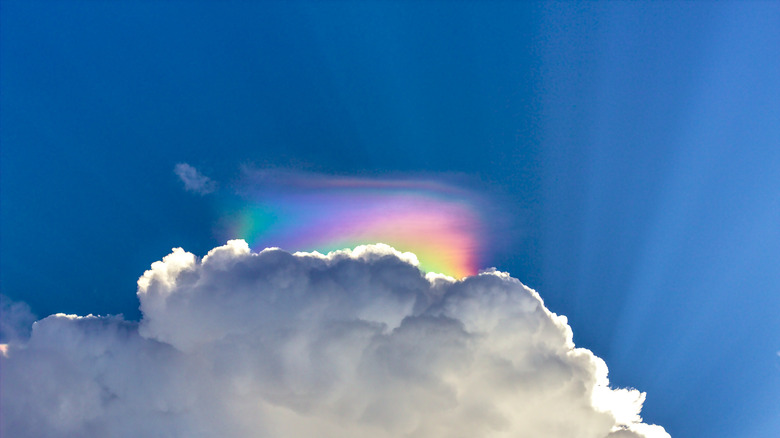Why A Circumhorizon Arc Is Not A Fire Rainbow
The northern lights, rainbows, and green flashes at sunrise or sunset are a just a few of the elusive optical phenomenon that are awesome to behold for those lucky enough to catch a glimpse. Another extremely rare occurrence, so uncommon most people have never even seen one or more than a fleeting glance, at least, is known as the circumhorizon arc.
A circumhorizon arc occurs when ice crystals in high cirrus clouds turn into floating prisms, refracting sunlight or moonlight, in a kaleidoscopic band of color that appears parallel to the horizon and usually above the clouds (via NASA). These arcs appear when the sun is high in the sky, at least 58 degrees, and, unless you live near the equator, they occur most often during the summer. The arcs are often confused with other rare occurrences in the atmosphere, too, including iridescent clouds and fire rainbows, according to EarthSky.
Confusing circumhorizon arc with fire rainbow
The colors in a circumhorizon arc are a well-defined parallel band, with reds and pinks at the top and blues at the bottom. While the two may look similar, iridescent clouds are a very different phenomenon because the colors appear as a mixture within the clouds and not as a band above them. Also, light refraction through ice crystals cause a circumhorizon arc while cloud iridescence is caused by water droplets (via EarthSky).
It's not surprising, either, that a circumhorizon arc is often mistaken for a fire rainbow, after all, the hues of a well-defined arc include the colors of a rainbow. Yet, unlike a rainbow, an arc appears above the clouds in a parallel band at a definite point on the horizon, and at its most spectacular, it actually appears in the shape of flames, thereby being mistaken for a fire rainbow. But not all circumhorizon arcs are so well-defined. In fact, most appear in more of a straight line above or even mixed in along the top of the clouds.
"Often only fragments are visible where there happen to be cirrus clouds — the individual patches of cirrus are then lit with color that can be mistaken for iridescence," according to Atmospheric Optics.
But even scientists have inadvertently interchanged descriptions of the circumhorizon arc and fire rainbow (via NASA), so it's certainly not unusual for the average person to confuse the two breathtaking phenomenon.

